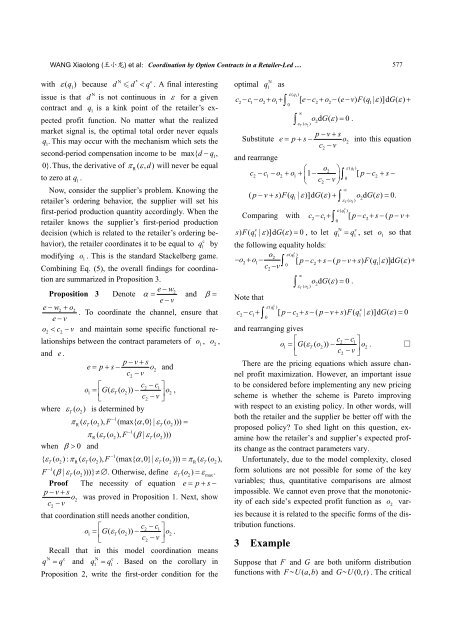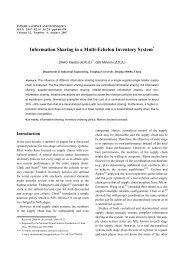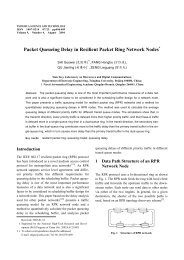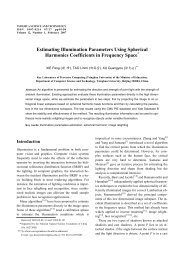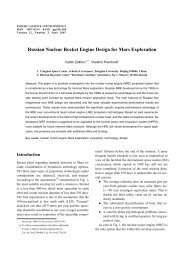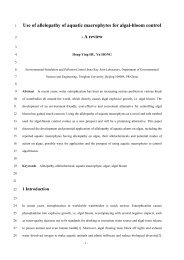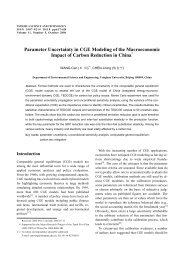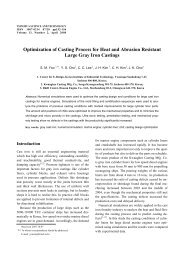Coordination by Option Contracts in a Retailer-Led Supply Chain with
Coordination by Option Contracts in a Retailer-Led Supply Chain with
Coordination by Option Contracts in a Retailer-Led Supply Chain with
Create successful ePaper yourself
Turn your PDF publications into a flip-book with our unique Google optimized e-Paper software.
WANG Xiaolong (王小龙) et al:<strong>Coord<strong>in</strong>ation</strong> <strong>by</strong> <strong>Option</strong> <strong>Contracts</strong> <strong>in</strong> a <strong>Retailer</strong>-<strong>Led</strong> …<br />
N * c<br />
<strong>with</strong> ε ( q1)<br />
because d d < q . A f<strong>in</strong>al <strong>in</strong>terest<strong>in</strong>g<br />
N<br />
issue is that d is not cont<strong>in</strong>uous <strong>in</strong> ε for a given<br />
contract and q 1 is a k<strong>in</strong>k po<strong>in</strong>t of the retailer’s expected<br />
profit function. No matter what the realized<br />
market signal is, the optimal total order never equals<br />
1 . q This may occur <strong>with</strong> the mechanism which sets the<br />
second-period compensation <strong>in</strong>come to be max{ d− q1,<br />
0}.Thus, the derivative of π R ( ε,<br />
d)<br />
will never be equal<br />
to zero at q 1 .<br />
Now, consider the supplier’s problem. Know<strong>in</strong>g the<br />
retailer’s order<strong>in</strong>g behavior, the supplier will set his<br />
first-period production quantity accord<strong>in</strong>gly. When the<br />
retailer knows the supplier’s first-period production<br />
decision (which is related to the retailer’s order<strong>in</strong>g be-<br />
c<br />
havior), the retailer coord<strong>in</strong>ates it to be equal to q 1 <strong>by</strong><br />
modify<strong>in</strong>g o 1 . This is the standard Stackelberg game.<br />
Comb<strong>in</strong><strong>in</strong>g Eq. (5), the overall f<strong>in</strong>d<strong>in</strong>gs for coord<strong>in</strong>ation<br />
are summarized <strong>in</strong> Proposition 3.<br />
e−w2 Proposition 3 Denote α = and β =<br />
e−v e− w2 + o2<br />
. To coord<strong>in</strong>ate the channel, ensure that<br />
e−v o2 < c2 − v and ma<strong>in</strong>ta<strong>in</strong> some specific functional relationships<br />
between the contract parameters of 1 o , o 2 ,<br />
and e .<br />
p− v+ s<br />
e= p+ s− o2and<br />
c2−v ⎡ c2 − c1⎤<br />
o1 =<br />
⎢<br />
G( εT<br />
( o2)) − o2<br />
c2−v ⎥ ,<br />
⎣ ⎦<br />
where T ( 2)<br />
o ε is determ<strong>in</strong>ed <strong>by</strong><br />
−1<br />
πR( εT( o2), F (max{ α,0}| εT(<br />
o2)))<br />
=<br />
−1<br />
πR( εT( o2), F ( β | εT(<br />
o2)))<br />
when β > 0 and<br />
−1<br />
{ εT( o2) : πR( εT( o2), F (max{ α,0}| εT( o2))) = πR( εT(<br />
o2),<br />
−1<br />
F ( β | εT(<br />
o2)))}<br />
≠∅. Otherwise, def<strong>in</strong>e T ( 2) max o ε = ε .<br />
Proof The necessity of equation e= p+ s−<br />
p− v+ s<br />
o2<br />
was proved <strong>in</strong> Proposition 1. Next, show<br />
c2−v that coord<strong>in</strong>ation still needs another condition,<br />
⎡ c2 − c1⎤<br />
o1 =<br />
⎢<br />
G( εT<br />
( o2)) − o2<br />
c2−v ⎥ .<br />
⎣ ⎦<br />
Recall that <strong>in</strong> this model coord<strong>in</strong>ation means<br />
N c<br />
N c<br />
q = q and q1 = q1<br />
. Based on the corollary <strong>in</strong><br />
Proposition 2, write the first-order condition for the<br />
optimal<br />
N<br />
q 1 as<br />
2 1 2 1<br />
ε ( q1<br />
)<br />
0<br />
2 2 1<br />
∫<br />
577<br />
c − c − o + o + [ e− c + o −( e− v) F( q | ε )]d G(<br />
ε ) +<br />
∫<br />
∞<br />
o<br />
(<br />
2d<br />
G(<br />
ε ) = 0.<br />
εT<br />
o2 )<br />
p− v+ s<br />
Substitute e= p+ s− o2<strong>in</strong>to<br />
this equation<br />
c2−v and rearrange<br />
⎛ o ( 1)<br />
2 ⎞ ε q<br />
c2 − c1− o2 + o1+ ⎜1 − [ p− c<br />
0<br />
2 + s−<br />
c2−v ⎟<br />
⎝ ⎠ ∫<br />
∞<br />
( p− v+ s) F( q | ε)]d G( ε) + o d G(<br />
ε)<br />
= 0.<br />
Compar<strong>in</strong>g <strong>with</strong><br />
1<br />
T ( 2 )<br />
2<br />
o ε<br />
c<br />
ε ( q1<br />
)<br />
2 1<br />
0<br />
2<br />
∫<br />
∫<br />
c − c + [ p− c + s−( p− v+<br />
c<br />
N c<br />
sFq ) ( 1 | ε)]d G(<br />
ε ) = 0,<br />
to let q1 = q1<br />
, set o 1 so that<br />
the follow<strong>in</strong>g equality holds:<br />
c o ε ( q1<br />
)<br />
2<br />
− o2+ o1− [ p− c<br />
0<br />
2+ s−( p− v+ s) F( q1| ε )]d G(<br />
ε ) +<br />
c −v∫ Note that<br />
2<br />
∫<br />
∞<br />
o d G(<br />
ε ) = 0.<br />
o<br />
ε (<br />
2<br />
T 2 )<br />
c<br />
ε ( q1<br />
)<br />
c<br />
2− 1+ − 2+ − − + 1<br />
0<br />
c c ∫ [ p c s ( p v s) F( q | ε )]d G(<br />
ε ) = 0<br />
and rearrang<strong>in</strong>g gives<br />
⎡ c2 − c1⎤<br />
o1 =<br />
⎢<br />
G( εT<br />
( o2)) − o2<br />
c2−v ⎥ . □<br />
⎣ ⎦<br />
There are the pric<strong>in</strong>g equations which assure channel<br />
profit maximization. However, an important issue<br />
to be considered before implement<strong>in</strong>g any new pric<strong>in</strong>g<br />
scheme is whether the scheme is Pareto improv<strong>in</strong>g<br />
<strong>with</strong> respect to an exist<strong>in</strong>g policy. In other words, will<br />
both the retailer and the supplier be better off <strong>with</strong> the<br />
proposed policy? To shed light on this question, exam<strong>in</strong>e<br />
how the retailer’s and supplier’s expected profits<br />
change as the contract parameters vary.<br />
Unfortunately, due to the model complexity, closed<br />
form solutions are not possible for some of the key<br />
variables; thus, quantitative comparisons are almost<br />
impossible. We cannot even prove that the monotonicity<br />
of each side’s expected profit function as o 2 varies<br />
because it is related to the specific forms of the distribution<br />
functions.<br />
3 Example<br />
Suppose that F and G are both uniform distribution<br />
functions <strong>with</strong> F~ U( a, b ) and G~ U(0, t ) . The critical


